Figure 1
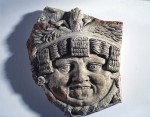
Roman – Fragment of a Red-Figure Vase, 350 BCE-325 BCE – terracotta
Gift of Edward Perry Warren, Esq., Honorary Degree, 1926
A mythical she-monster linked with the sea, Scylla is often depicted with the head and upper body of a young woman, a waist of dog heads, and (missing here) the tail of a fish. According to some traditions, Scylla was a lovely young woman transformed into a monster by either the sorceress Circe or the sea goddess Amphitrite, out of jealousy for her beauty. The horse shown on the fragment may emphasize her association with Poseidon, god of the sea and of horses, who loved her. After her transformation, she takes up a position opposite the whirlpool Charybdis in the straits of Messina off Sicily. Her ravenous nature is well documented in Homer’s Odyssey, where she gobbles up six of Odysseus’s men as his ship passes by. The myth of Scylla underscores the notion of women as consumers, drawing men to them only to destroy them.
Figure 2
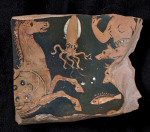
Roman – Fragment of Revetment Plaque Head of the Gorgon Medusa, first century BCE – terra cotta
Gift of Edward Perry Warren, Esq., Honorary Degree, 1926
Medusa is one of the three Gorgons, monstrous females who are usually identified as the daughters of the sea-god Phorcys. Unlike her two sisters, Medusa is mortal. According to some myths, she was a beautiful maiden before being transformed into a Gorgon guise with snaky hair, a massive tongue, prominent teeth, glaring eyes and occasionally wings or a beard. Her transformation was induced by Athena’s rage—Medusa slept with Poseidon in her temple. Capable of petrifying any man who looked at her face, she was eventually slain by the Greek hero Perseus, who kept her head in a magic bag. Perseus used Medusa’s head to defeat his enemies. Thereafter, Athena placed the head on her shield. The Gorgon face was found throughout the ancient world as an apotropaic device (meant to ward off danger) on shields, temples and tombs. The Medusa/Gorgoneion tradition shows connections between women and lurking, dangerous natural forces that men strive to master.
Figure 3
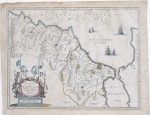
ABRAHAM ORTELIUS (Flemish, 1527–1598) Map of Fezzae and Morocco, 1570, 1635 – hand-colored map
Gift of Sandy and Chris Potholm
Maps from the sixteenth and seventeenth centuries often featured voluptuous female personifications and dramatic historical women. Period representations of the interior of the African continent typically reflected a blank canvas of mystery and exoticism associated with orientalizing (and feminizing) the region. Yet in this map of Morocco and the surrounding Mediterranean Sea by the famed Flemish cartographer Ortelius, women are absent. Surprisingly, women later capitalized on these connections between geography and gender. Margherita Costa’s comedy The Buffoons (1642) is set in the city Fes (in Italian, Fezza or Fessa), Morocco, a slang term for female genitalia. The comedy routinely exploits sexually explicit double entendres generated from the Italian language and Moroccan geography. The association between a foreign land and women’s bodies came together again in Edith Wharton’s 1918 memoir when she expresses her excitement at seeing a veiled North African woman: All the mystery that awaits us looks out through the eye-slits in the grave-clothes muffling her.
Figure 4
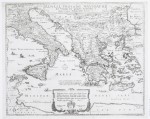
WENCESLAUS HOLLAR (Bohemian, 1607–1677) Map of the Voyages of Aeneas, ca. 1650 – engraving
Gift of Charles Pendexter
Maps from the sixteenth and seventeenth centuries often featured voluptuous female personifications and dramatic historical women. Period representations of the interior of the African continent typically reflected a blank canvas of mystery and exoticism associated with orientalizing (and feminizing) the region. Yet in this map of Morocco and the surrounding Mediterranean Sea by the famed Flemish cartographer Ortelius, women are absent. Surprisingly, women later capitalized on these connections between geography and gender. Margherita Costa’s comedy The Buffoons (1642) is set in the city Fes (in Italian, Fezza or Fessa), Morocco, a slang term for female genitalia. The comedy routinely exploits sexually explicit double entendres generated from the Italian language and Moroccan geography. The association between a foreign land and women’s bodies came together again in Edith Wharton’s 1918 memoir when she expresses her excitement at seeing a veiled North African woman: All the mystery that awaits us looks out through the eye-slits in the grave-clothes muffling her.
Figure 5
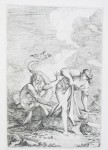
SALVATOR ROSA (Italian, 1615–1673) – Glaucus and Scylla, 1624 – etching
Gift of Leo Steinberg
The Roman poet Ovid, in his Metamorphoses, recounts how Glaucus tried to appeal to Scylla by telling of his transformation from human to god, acquiring his bronze-green beard and sea-blue arms. Unmoved, she escapes over the sand where he cannot follow. The enraged Glaucus seeks out the sorceress Circe, who exacts revenge upon the girl. Scylla is turned into a hideous monster; the heads of raging dogs (see the ancient pottery fragment in this exhibition) spring from her waist. Enraged, the previously beautiful nymph becomes a terror of the sea, destroying mariners. Rosa’s print shows the still lovely nymph, prior to her punishment for not being sexually acquiescent. She is fleeing from the ugly fish-tailed, anguished sea deity Glaucus. His flailing fish tail foreshadows his inability to pursue his beloved, and the devastation he will enact on her in revenge.
Figure 6
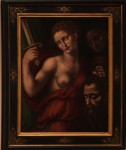
“UNKNOWN ARTIST (Italian) – Judith Holding the Head of Holofernes, 1550–1599 – egg tempera on panel
Gift of the Heirs of the Estate of Lillian L. Harding
According to legend, the pious Jewish widow Judith gained the trust of Assyrian general Holofernes in order to kill him and prevent a siege of Jerusalem. Seen as both seductive and chaste, as a heroine and as a threat to masculine power, Judith has inspired representations in theater and the visual arts for centuries. Because of these tensions, an artist’s decision about which moment of the narrative to depict carries important weight. Compare these two versions of Judith. In this painting she is bare-chested and triumphantly holds the severed head aloft.
Figure 7

CHRISTOFFEL VAN SICHEM, THE ELDER (Dutch, 1546–1624) Judith with the Head of Holofernes, 1630 – chiaroscuro woodcut
Gift of David P. Becker, Class of 1970
According to legend, the pious Jewish widow Judith gained the trust of Assyrian general Holofernes in order to kill him and prevent a siege of Jerusalem. Seen as both seductive and chaste, as a heroine and as a threat to masculine power, Judith has inspired representations in theater and the visual arts for centuries. Because of these tensions, an artist’s decision about which moment of the narrative to depict carries important weight. Compare these two versions of Judith. In this woodcut she is modestly clothed and deposits Holofernes’ head into a bag. In this painting she is bare-chested and triumphantly holds the severed head aloft.
Figure 8

GIOVANNI CESARE TESTA (Italian, 1630/1640–1655) – Dido on the Funeral Pyre, ca. 1655 – etching.
Museum Purchase, Lloyd O. and Marjorie Strong Coulter Fund
The Carthaginian queen Dido epitomizes an intelligent, courageous and powerful woman brought low by the powers of love and betrayal. The most influential version of her tragedy appears in Virgil’s Aeneid, written to praise Rome’s glory through the heroic tale of Aeneas, its founder. Dido welcomes the Trojan hero Aeneas to her city, and through Venus’s conniving, falls in love with him. The despairing Dido takes her life using Aeneas’ sword after he abandons her to found the Roman Empire across the Mediterranean Sea. In this print, Dido’s companions howl with grief and turn away in horror at their queen’s suffering as she dies upon the funeral pyre.
Figure 9
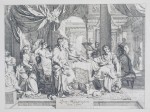
GERARD DE LAIRESSE – Banquet of Cleopatra, 1670 – etching on paper
Museum Purchase
In this print Queen Cleopatra of Egypt reclines voluptuously, partially undraped, at a lavish banquet table at which she entertains the Roman general Marc Anthony. This scene is described in Natural History by the first century Roman writer Pliny the Elder. Vain and arrogant, Cleopatra wagers with Antony that she could have a magnificent banquet prepared that would cost ten million sesterces (equivalent to over a billion dollars today). Cleopatra wins the wager by dissolving her rare and fabulously large pearl earring in her cup of wine, drinking from the cup, and thus winning the wager. Pliny’s story paints an image of a politically devious and intriguing monarch, who cleverly snares the Roman general in her luxurious web of seduction, leading ultimately to the downfall and death of both. Written from the perspective of victorious Rome, Pliny’s story vilifies and sexualizes the defeated female ruler, and provides a cautionary tale about the wiles of women.
Figure 10
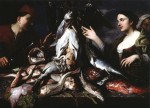
UNKNOWN ARTIST, Italian, Seventeenth Century – The Fish Seller and his Customer (formerly Fish Shambles) – oil on canvas
Bequest of the Honorable James Bowdoin III
The youthful fishmonger holding out his knife seems stunned into immobility by the pretty young customer whose low-cut bodice highlights her smooth white skin. As an amorous transaction begins, the selling and buying of fish seems to be forgotten. The pile of slimy and scaly fish offers symbolic commentary and visual puns regarding the exchange between the couple. On the left a toothy monkfish opens its jaws; at center a skate hangs disemboweled, intestines slipping out of the slashed open belly. To the right, a large cod lies stiffly along the table’s edge. Two of these bodies offer moist yet slightly repellent openings. The cod lies in an upward rising diagonal. In a culture where cod” was slang for a man’s virile member and women’s intimate odors were described as fishy, viewers might well have enjoyed the many puns that alluded to an erotic encounter.
Figure 11
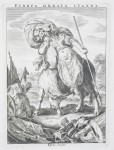
CLAES JANSZ. VISSCHER (Netherlandish, ca. 1550–ca. 1612) – Europe, from The Four Continents, ca. 1653
Fenimore Art Museum (New York State Historical Association), Cooperstown, NY
These dramatic female representations of Europe, Asia, and Africa—the three continents that border the Mediterranean—mourn the unexpected death of Portuguese Prince Theodosius III (died 1653) at age nineteen. The well-armored Europe takes pride of place, dressed like Athena with her spear at the ready. According to the Latin titles, outraged Africa complains and exhausted Asia sighs. The histrionics of Africa and luxurious turban and drapery of Asia pictured with exotic fauna reinforce a hierarchy of the continents topped by civilized Europe. Personifications of geographical regions were meant to be self-evident to their early modern European readers, and were often juxtaposed with maps. Since early modern viewers were expected to create their own narrative from the images, this series asks: what differences distinguish the continents and what feminine similarities unite the grieving women?
Figure 12
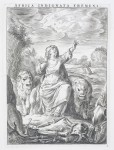
CLAES JANSZ. VISSCHER (Netherlandish, ca. 1550–ca. 1612) – Africa, from The Four Continents, ca. 1653
New Haven Colony Historical Society, New Haven, CT
These dramatic female representations of Europe, Asia, and Africa—the three continents that border the Mediterranean—mourn the unexpected death of Portuguese Prince Theodosius III (died 1653) at age nineteen. The well-armored Europe takes pride of place, dressed like Athena with her spear at the ready. According to the Latin titles, outraged Africa complains and exhausted Asia sighs. The histrionics of Africa and luxurious turban and drapery of Asia pictured with exotic fauna reinforce a hierarchy of the continents topped by civilized Europe. Personifications of geographical regions were meant to be self-evident to their early modern European readers, and were often juxtaposed with maps. Since early modern viewers were expected to create their own narrative from the images, this series asks: what differences distinguish the continents and what feminine similarities unite the grieving women?
Figure 13
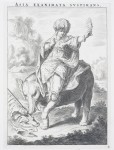
CLAES JANSZ. VISSCHER (Netherlandish, ca. 1550–ca. 1612) – Asia, from The Four Continents, ca. 1653
Fenimore Art Museum (New York State Historical Association), Cooperstown, NY
These dramatic female representations of Europe, Asia, and Africa—the three continents that border the Mediterranean—mourn the unexpected death of Portuguese Prince Theodosius III (died 1653) at age nineteen. The well-armored Europe takes pride of place, dressed like Athena with her spear at the ready. According to the Latin titles, outraged Africa complains and exhausted Asia sighs. The histrionics of Africa and luxurious turban and drapery of Asia pictured with exotic fauna reinforce a hierarchy of the continents topped by civilized Europe. Personifications of geographical regions were meant to be self-evident to their early modern European readers, and were often juxtaposed with maps. Since early modern viewers were expected to create their own narrative from the images, this series asks: what differences distinguish the continents and what feminine similarities unite the grieving women?
Figure 14
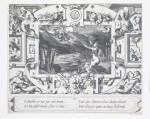
RENÉ BOYVIN (French, ca. 1525–ca. 1625) – Medea Watching a Chariot Drawn by Dragons, after Leonard Thiry, 1563 – engraving
Bequest of David P. Becker, Class of 1970
One of twenty-six prints that recount the myth of the hero Jason and the Golden Fleece, this, print shows the princess and sorceress, Medea. After Medea assisted Jason and betrayed her own family, she fled to Greece to become his bride. There Jason begged her to use her magic to rejuvenate his ancient father, Aeson. Medea agreed and called upon the goddess of the underworld, Hecate, to help her gather special herbs for the potion. When the moon reached its full brightness, Medea called down her dragon chariot and sped to distant lands to harvest the plants. Medea appears three times in this print. She stands in the foreground, almost naked beneath the night sky, her long hair flowing. Her nudity stresses her sexuality and connects it with the powerful and dreadful forces of nature. She is depicted twice more, in the top right and left, driving her chariot through the clouds.
Figure 15
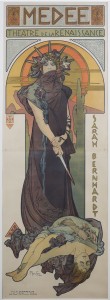
ALPHONSE MUCHA (Czechoslovakian, 1860–1939) – Medee, Theatre de la Renaissance, Sarah Bernhardt, 1898 – lithograph
Gift of Hilton and Esta Kramer
This lithographic poster by Alphonse Mucha shows the famed Parisian actress Sarah Bernhardt in the epic stage role of Medea, a character haunted by passion and twisted vengeance. In the Greek tragedy, Medea’s once-beloved husband Jason abandons her and their children in order to marry the princess of Corinth. His infidelity leads Medea down a destructive path towards murder; she kills her two sons in a monstrous pursuit of justice. Mucha expresses the tragedy’s tension by contrasting Medea’s helpless vacant eyes with the horrific infanticide at her feet. Her merciless violence toward her family threatens patriarchal authority and conveys the warning that jealous women are irrational and destabilizing.
Figure 16
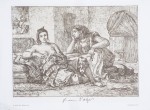
EUGÈNE DELACROIX (French, 1798–1863) – Femme d’Algiers, ca. 1840 – lithograph
Museum Purchase, James Phinney Baxter Fund, in memory of Professor Henry Johnson
In 1832, two years after the French invasion of Algeria, Eugène Delacroix journeyed to Morocco as part of a French ambassadorial delegation. He was anxious to see a harem during his voyage, which he was able to do in Algiers, on his return journey to France. Representations of harems put exotic women on display and were presumed to offer a view into an institution that was traditionally off-limits to foreigners. Pictures of harems titillated European viewers by their inherent sense of moral transgression. When viewed by a foreign audience, the women’s eroticized body became a readily available object of desire. The absent gaze and immobility of the seated women in this print accentuate their objectification. The women seem unaware of their bodies and, by extension, their existence.
Figure 17
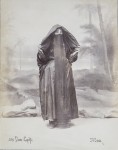
J.P. SEBAH (Turkish, 1872–1947, also active in Cairo) – Dame Copte, ca. 1900 – vintage albumen print
Gifts of Isaac Lagnado, Class of 1971
During the late nineteenth and early twentieth century, studio photographs from Turkey and Egypt, like those shown here, perpetuated the eroticization of Eastern women. Female models were hired to represent all ethnic and religious types and were photographed in residential studios throughout the Middle East. These staged photographs of veiled women were sold to European tourists as souvenirs. The veil challenges male visual desire because it offers concealment and modesty. A woman can see the spectator, but does not let herself be seen. The veil also incites a longing to reveal what is inaccessible and unknowable, contributing to the exoticization of women of the Middle East and Africa among foreign audiences.
Figure 18
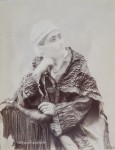
J.P. SEBAH (Turkish, 1872–1947, also active in Cairo) – Turkish Woman with Veil, ca. 1900 – vintage albumen print
Gifts of Isaac Lagnado, Class of 1971
During the late nineteenth and early twentieth century, studio photographs from Turkey and Egypt, like those shown here, perpetuated the eroticization of Eastern women. Female models were hired to represent all ethnic and religious types and were photographed in residential studios throughout the Middle East. These staged photographs of veiled women were sold to European tourists as souvenirs. The veil challenges male visual desire because it offers concealment and modesty. A woman can see the spectator, but does not let herself be seen. The veil also incites a longing to reveal what is inaccessible and unknowable, contributing to the exoticization of women of the Middle East and Africa among foreign audiences.
Figure 19

PABLO PICASSO (Spanish, 1881–1973) – Untitled, ca. early 1950s – ceramic plate
Bequest of William H. Alexander
Picasso increasingly worked with ceramics after World War II, invigorated by the Mediterranean’s classical motifs and native material of clay. He encountered a pottery studio at the coastal village of Villauris, where an ancient Roman kiln was still in use. There he began combining craft and painting into a unified art form, in the manner of Greek vases. This ceramic plate may be quadruple profile of Françoise Gilot, Picasso’s companion from 1944 to 1953. The blue-green and black lines against a white background reflect Muslim-influenced ceramics from Spain.
Figure 20
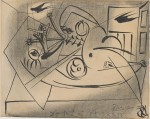
PABLO PICASSO (Spanish, 1881–1973) – Construction with Swallows, 1934 – India ink and charcoal
Bequest of William H. Alexander, in memory of his friend, Howard Hoyt Shiras, M.D.
In this drawing, marked by Surrealist overtones, Picasso aggressively distorts the figure of a classically-posed reclining female nude. This disfiguration may reflect Picasso’s tense emotional state due to conflict with his wife Olga, whom he frequently depicted as an enraged monster. Picasso began a secret relationship with Marie-Thérèse Walter in 1927, and would leave Olga a year after this print was created. The swallows, shown here in visual shorthand as energetic dashes of black ink, are a migratory bird that symbolizes renewal and change. Created during the geopolitical instability of the inter-war years, this drawing contrasts with the female portraits Picasso produced after World War II that convey a return to classicism and balance.
Figure 21

PABLO PICASSO (Spanish, 1881–1973) – Head of a Girl, ca. 1955 – lithograph
Museum Purchase
This profile of a girl with a wreath of flowers recalls the many portraits Picasso painted of his muse and second wife Jacqueline Roque. He often depicted Roque with large, expressive eyes and presenting a sense of distance and melancholy. After World War II, Picasso returned to classical themes that he had interpreted earlier in his career. This lithograph shows the Mediterranean ideal of feminine beauty from which emanates harmonious and balanced strength. Picasso perpetuates the representation of women as seductive muse and originator of life.